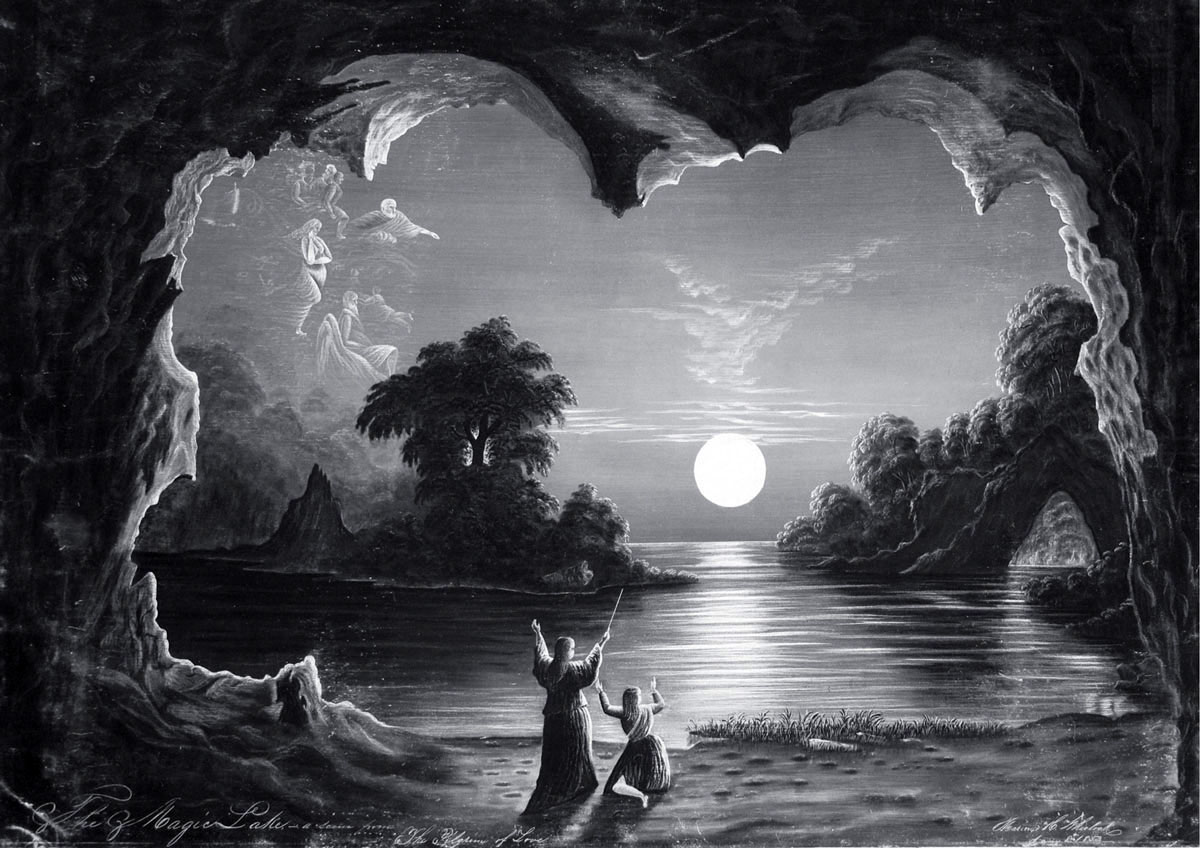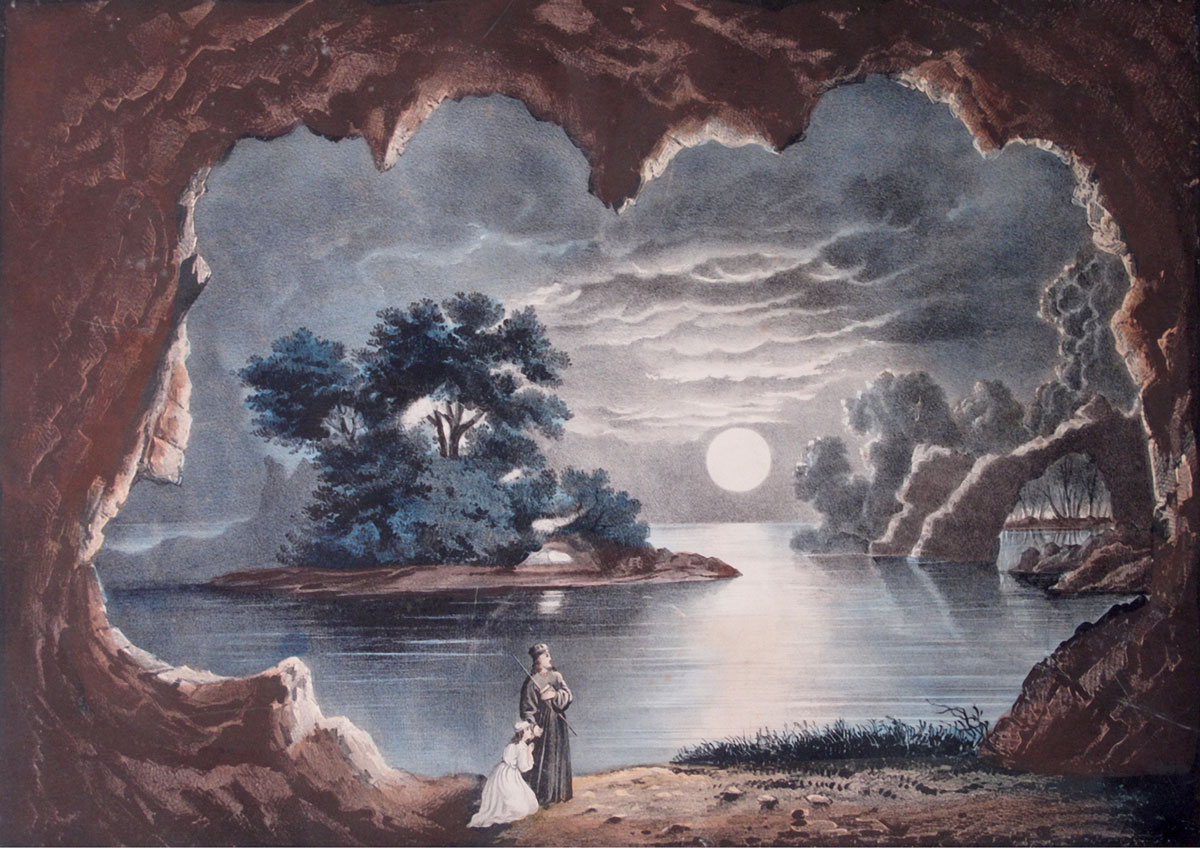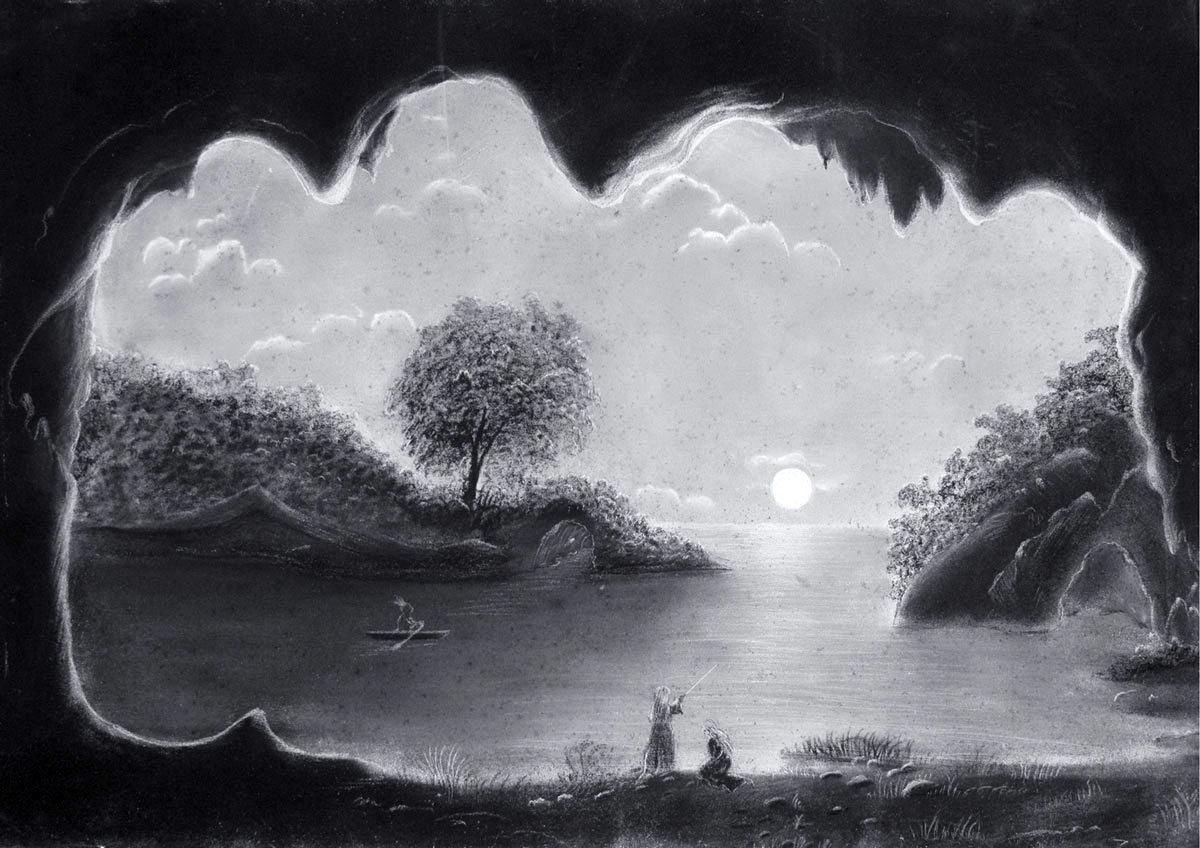The Magic Lake
Drawing lines in the sand
Valerie Smith
In the long American tradition of itinerant tradesmen, entertainers, and teachers who made their living traveling across the country, one of the more intriguing figures was that of the wandering artist and instructor. Among the unusual skills in which a nineteenth-century enthusiast could be tutored was the art of drawing on marble dust. A discipline that lay somewhere between novelty, craft, and draftsmanship, these artworks—“monochromatic paintings,” as they were later called—were done on various-sized paperboards of relatively thick ply to which a thin white wash of a glue adhesive was applied. Just before the wash dried, a thin layer of marble dust would be evenly sifted over the surface, where it adhered. When the dust had set in the wash, a drawing, usually in charcoal or black crayon, was added.
Known mistakenly today as “sandpaper drawings” for the sparkle and texture the marble dust imparted to their surfaces, these works first began appearing in the US in the mid-1830s, after a book describing the technique—B. F. Gandee’s The Artist, or Young Ladies’ Instructor in Ornamental Painting, Drawing, &c.—was published in London and New York.[1] These drawings seem to have been produced widely, but particularly in the Northeast, and although men also practiced the medium—including famous figures such as Albert Bierstadt—the majority of signed pictures reveal a woman’s name. Indeed, draftsmanship was an essential element of every young woman’s education, and instruction books such as Gandee’s were found in the library of every young lady of breeding—even the Brönte sisters had one. Since there were few women’s academies and seminaries at the time, it is probable that the itinerant instructors earned their keep through individual instruction, as well as teaching groups in town halls (which served cultural as well as civic purposes) and the drawing rooms or back parlors of larger private homes.
The motifs of marble dust drawings vary greatly. The predominant sources were penny prints, engraved images featuring landscapes or touristic scenes already found on the walls of many middle-class homes. Sources also included publications such as Barlett’s Classic Illustrations of America: All 121 Engravings from American Scenery, of 1840, or the inexpensive and popular pictures of New York City printers Currier and Ives.
Of all the subjects marble dust artists drew, the “Magic Lake” is one of the most mysterious. Like many of the artform’s themes, this one derived from a print. It was in this way that artists such as Marion Wheelock, a middle-aged woman bed-ridden with tuberculosis, came to draw The Magic Lake in the winter of 1853. Her interpretation is faithful to the original source, a print published in the April 1852 issue of Sartain’s Union Magazine of Literature and Art.[2] The print was designed by James Hamilton and translated into a mezzotint by Sartain himself to illustrate Henry Beck Hirst’s poem The Pilgrim of Love.
Hirst’s verse poem tells the story of Brunhilda, who dreams of a handsome king. In her quest to find her love, she embarks on a journey and meets a hermit who mysteriously knows of her quest. He invites her to rest in his cave and in the morning informs her that the king is in fact a spirit that he can summon. The hermit instructs her to travel to a ruined abbey and throw herself into an open tomb in order to leave the mortal world behind and enter paradise, where her lover awaits.
The Pilgrim of Love—with its “wehr wolves,” witches, castles, and kings mixed in with sacred and profane love—satisfied because it was an amalgam of Dante, Wagner, Shakespeare and lesser-known writers such as the Englishman John Graham, whose 1836 poem Geoffrey Rudel: or The Pilgrim of Love recounts a Christian crusade in which a love story ends in death. Hirst’s tale, with its promise of fulfillment in the afterlife, would obviously have been alluring to the dying Wheelock. But there were many such visions on offer in the former colonies at that time. An enormous groundswell of religious feeling took hold in America during the wave of mid-nineteenth-century “Great Awakenings,” in which the question of one’s personal faith merged with socio-political and pedagogic concerns into a kind of national ethics. Between the third (1830) and the fourth (1857) Great Awakening, Thomas Cole produced his “Voyage of Life” paintings (1840), which were translated into engravings by James Smillie after the artist’s death in 1848 and widely distributed in the US. The engravings spread the Christian message of the paintings: God is in nature and it will deliver you. Like Cole’s angel, who safely navigates the four stages of Man through the turbulence of life, the spiritual leader in Wheelock’s rendering, also drawn between these periods of religious fervor, leads his charge from the darkness to the light of the magic lake and its promised paradise.



- As a reviewer of Gandee’s new technique pointed out, the method had already been identified by William Kingston as “Grecian Painting” in his The Kingstonian System of Painting in Dry Colors, After the Ancient Grecian Method. See The Literary Gazette and Journal of Belles Lettres, Arts, Sciences, &c., 7 March 1835, p. 157.
- Shelley R. Langdale, “The Enchantment of the Magic Lake: The Origin and Iconography of a Nineteenth-Century Sandpaper Drawing,” in Folk Art, Winter 1998/1999, pp. 52–62.
Valerie Smith is the director of visual arts, media, and film at Haus der Kulturen der Welt in Berlin, where she recently curated the exhibition “Rational/Irrational.” She is currently working on a project about rage.